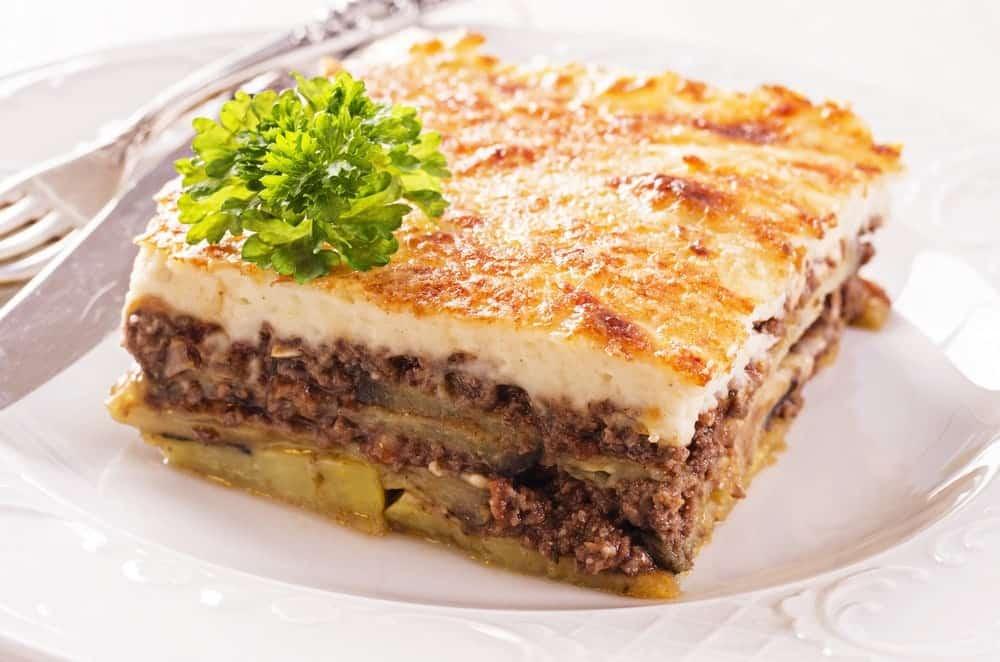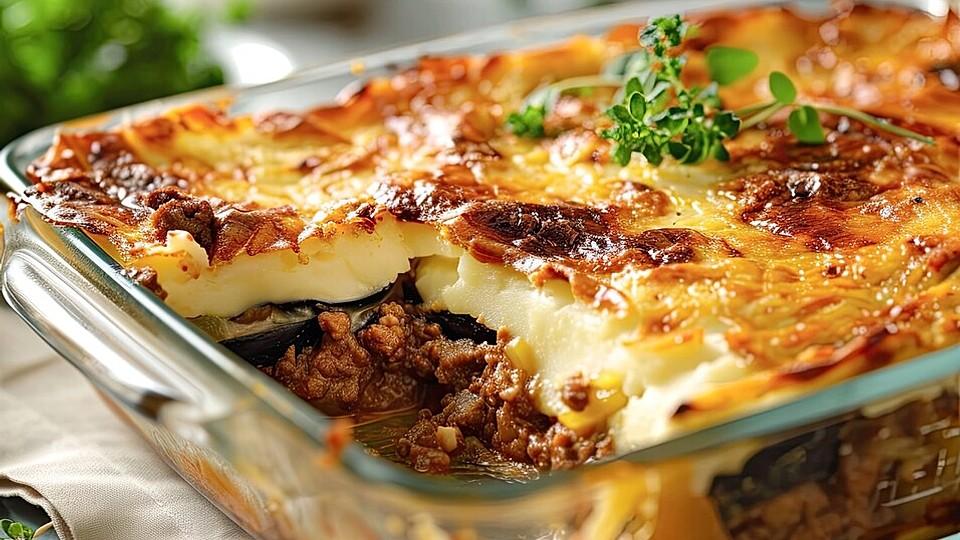When it comes to comfort food, few dishes can rival the hearty allure of lasagna. layers of tender pasta, rich sauce, and cheese create a symphony of flavors that has captured the hearts of many. But what if we take a culinary journey to the sun-kissed shores of the Mediterranean and breathe new life into this beloved classic? Enter Greek moussaka, an exquisite dish that reimagines the lasagna experience through the lens of Greek culinary tradition. With its fragrant spices, tender eggplant, and creamy béchamel, moussaka invites you to savor the essence of Mediterranean cooking while indulging your cravings for something warm and satisfying. In this article, we will explore the rich history of moussaka, its key ingredients, and how this delightful dish serves as a flavorful tribute to communal dining and family gatherings, ensuring that every serving tells a story of heritage and flavor. Join us as we delve into the world of Greek moussaka—a culinary masterpiece that offers a delicious twist on a classic favorite.

Exploring the Origins: The Culinary Roots of Greek Moussaka
Tracing the culinary lineage of moussaka unravels a tapestry woven from a rich history of diverse cultural influences. Believed to have ancient roots, this beloved dish has evolved through centuries, incorporating a myriad of ingredients and cooking techniques from both the Eastern Mediterranean and beyond. Eggplants, minced meat, and aromatic spices stand as the star trio in this dish, each bringing its own story to the table. The layering of these components mirrors the waves of migration and trade that have shaped Greek cuisine, showcasing how local ingredients and foreign flavors can harmoniously blend.
In its contemporary form, moussaka showcases the lovely melding of Greek and Middle Eastern traditions. The introduction of spices like cinnamon and nutmeg in the meat sauce adds an unexpected warmth, distinctively setting moussaka apart from its Italian counterpart, lasagna. To appreciate the multifaceted nature of this dish, consider the following ingredients that play a pivotal role in its creation:
- Ground meat: Traditionally lamb or beef, symbolizing the pastoral heritage of Greece.
- Eggplant: A staple in Mediterranean diets, bringing a subtle sweetness.
- Bechamel sauce: A creamy topping that adds richness, perfected by French culinary techniques.
From its humble beginnings to its status as a gastronomic icon, moussaka invites palates on a culinary journey through history.

Layering Flavors: The Art of Constructing the Perfect Moussaka
Crafting the ideal moussaka is all about layering flavors to create that rich, comforting experience that is a hallmark of Mediterranean cuisine. Start with sautéed onions and garlic,which form the aromatic base for the dish. Combine with ground lamb or beef, infusing it with spices like cinnamon and nutmeg for a subtle warmth that tingles on the palate. Afterward, incorporate a touch of red wine to elevate the flavor profile. Once your meat mixture is bubbling, introduce tomatoes—fresh or canned—for acidity and balance.allow this savory melange to simmer until it thickens, concentrating those delightful flavors that will resonate throughout the layers of moussaka.
Next comes the building of textures with sliced eggplant and potatoes. These ingredients not only provide a satisfying bite but also serve as a canvas for the luxurious creamy béchamel sauce that will crown the dish. When assembling, alternate layers of the meat sauce, eggplant, and potatoes, ensuring that each stratum is seasoned to perfection. The finishing touch—a generous sprinkle of grated kefalotyri or parmesan cheese—will caramelize beautifully in the oven, creating a golden crust. Below is a simple breakdown of the essential layers to consider when constructing this beloved classic:
| Layer | Main Ingredients |
|---|---|
| Base | Sautéed onions, garlic, ground meat |
| Vegetable Layer | Eggplant, potatoes |
| Béchamel | Butter, flour, milk, cheese |
| Topping | Grated cheese |

Ingredient Spotlight: Essential Components That Elevate Your Dish
Each layer of Greek moussaka is a festivity of flavors and textures, and the essential ingredients play a vital role in creating this culinary masterpiece. At the heart of this dish is the perfectly cooked eggplant, which adds a creamy richness, while simultaneously absorbing the juicy depths of the accompanying sauces. The architecture of flavors is complemented by the savory ground lamb or beef, seasoned with aromatic spices that transport you right to the Mediterranean shores. Additionally, the layer of potatoes provides a hearty foundation, offering a satisfying bite that balances the softer vegetables.
No dish would be complete without a luscious béchamel sauce, which crowns the moussaka in a velvety blanket. The critical ingredients in this sauce are high-quality butter, flour, and milk, blended into a creamy consistency that brings everything together.To elevate the flavor further, a hint of nutmeg is often added, creating a warm and nuanced profile. Explore the delightful harmony of these components and discover how they interact, each bite revealing the artistry behind this beloved Mediterranean comfort food.

Serving Suggestions: Pairing Moussaka with Traditional Accompaniments
When indulging in a delicious plate of moussaka, consider complementing the dish with traditional Greek accompaniments that elevate its rich flavors. A vibrant Greek salad is an ideal starter,showcasing a medley of ripe tomatoes,crisp cucumbers,red onions,and Kalamata olives,all drizzled with extra virgin olive oil and a sprinkle of feta cheese. Another excellent pairing is a side of tzatziki sauce, a refreshing yogurt-based dip infused with garlic, cucumber, and dill, perfect for layering on top of the moussaka or simply enjoying with warm pita bread.
For a truly immersive dining experience, you might also consider adding a glass of Greek wine to your meal. Varietals such as Assyrtiko or Agiorgitiko offer crisp and fruity profiles that harmonize beautifully with the savory depth of moussaka. To enhance the meal further, serve it alongside a small dish of spanakopita—savory spinach and feta-filled pastries wrapped in flaky phyllo dough. For those with a sweet tooth, finish your meal with a light serving of baklava, bringing a sweet and nutty conclusion to your Mediterranean feast.
Key Takeaways
As we wrap up our culinary journey through the layers of Greek moussaka, it becomes clear that this Mediterranean masterpiece is more than just a delicious dish; it is a celebration of culture, history, and the artistry of cooking. Each bite resonates with the warmth of Mediterranean sun, from the rich flavor of spiced ground meat to the velvety embrace of béchamel sauce. While moussaka pays homage to lasagna with its own unique twist, it stands proudly as a symbol of the region’s vibrant gastronomic heritage.
Whether you’re a seasoned chef looking to expand your repertoire or a culinary novice eager to try something new, moussaka invites you to savor the magic of Greece in your own kitchen. So gather your ingredients, embrace the process, and let the aromas transport you to sun-kissed shores and bustling tavernas. As you serve this dish to friends and family,remember that,just like lasagna,the true essence of moussaka lies not only in its flavors but in the shared moments and memories created around the table. Bon appétit!